Is it possible to eat honeysuckle while losing weight and how is it useful?
Honeysuckle (the name of this plant can be deciphered as “life and youth”) is called rejuvenating berries due to its unique composition. Today we will talk about the value of edible honeysuckle as a dietary product. Let us dwell in detail on the beneficial properties, restorative, protective and cleansing effects of the fruits of this shrub.
Why is honeysuckle good?
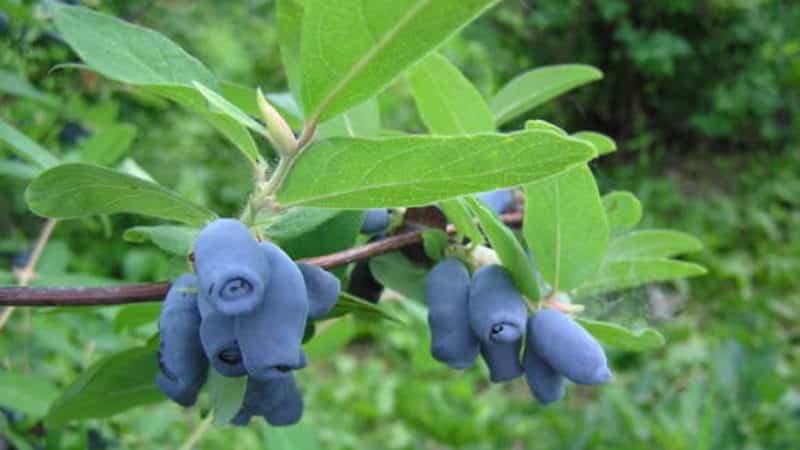
Edible honeysuckle is a storehouse of vitamins and macroelements. Today it can increasingly be found in summer cottages in central Russia.
These shrubs with elongated bluish berries do not require complex care and tolerate severe frosts well. They also withstand heat and drought stoically.
Fact. Honeysuckle is the most frost-resistant and winter-hardy crop. The bark and wood can withstand frosts down to -50°C, roots and flower buds - up to -40°C. The most amazing thing is that the buds successfully develop at a temperature of -8°C. And despite any weather surprises, you will always get an excellent harvest.
To replenish the supply of vitamins, the berry season of edible honeysuckle opens at the end of May.
The fruits ripen in the central part of Russia in the second half of May, 2-3 weeks earlier than garden strawberries.
In terms of taste and beneficial qualities, the following varieties are recognized as leaders:
- Gerda – early-ripening, early-fruiting variety. The bush is medium-sized, with erect shoots. The fruits are oval, dark blue with a bluish tinge. The taste of the berries is sweet and sour, the flesh is tender.
- Enchantress – mid-season variety.The bush is low, the shoots are thin, slightly pubescent. The berries are large (up to 2 cm in length), elongated, pitcher-shaped. The fruits are juicy, refreshing, thin skin, dessert taste, sweet and sour.
- Violet - mid-season variety. It is considered the best variety for the Moscow region. Its peculiarity is that it is a small shrub, dense, compact, with a rounded crown. The berries are smooth, dark blue with a waxy bluish coating. The fruit itself is elongated, in the shape of a jug. The pulp is fibrous, sweet and sour in taste, the peel is dense.
These varieties are characterized by high productivity and resistance to diseases and garden pests. There is no need for chemical treatment, which is important for growing an environmentally friendly product.
Calorie content and BZHU
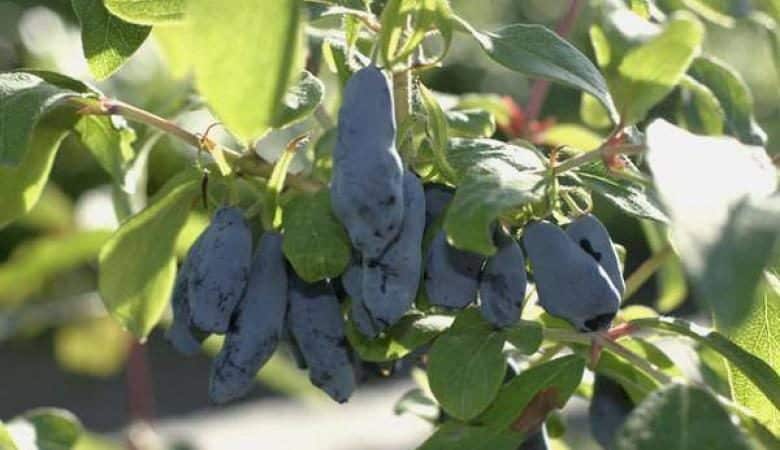
The fruits are low-calorie - 30-40 kcal per 100 g, depending on the variety and growing conditions.
The ratio of protein-fat carbohydrates per 100 g of edible part is 0/0/8.5 g.
80% of the pulp consists of water, digestible carbohydrates (mono- and disaccharides) - up to 6% of the daily requirement. Organic acids in berries contain up to 3%, and pectins – 2%.
Composition and beneficial properties
Due to its rich chemical composition, the berry can safely be called a multimitamine.
Important. Honeysuckle berries are record holders for ascorbic acid content. According to this indicator, the product outperformed gooseberries, kiwis, oranges, strawberries and raspberries.
100 g of fresh berries contains:
- up to 150 mg of vitamin C (more than 100% of the daily requirement. Mobilizes immune processes, participates in metabolic processes, prevents capillary fragility.
- 3 mg vitamin B1. Thiamine is an important enzyme in energy and carbohydrate metabolism; it supplies energy and plastic substances.
- 3.2 mg vitamin B2.Riboflavin increases the sensitivity of visual analyzers, protects against ultraviolet radiation, and is an antioxidant.
- 0.3 mg beta-carotene. Vitamin A provitamin promotes the health of the skin, gastric and intestinal mucosa, and is necessary for the organs of vision.
- 50 mcg of vitamin A. Retinol synthesizes collagen, maintains and restores the epithelium.
Mineral composition:
- 70 mg of potassium - regulates water balance, stabilizes heart rate, improves oxygen supply to the brain;
- 40 mg of silicon - it is called the element of longevity - increases the body's resistance;
- 35 mg sodium - normalizes water-salt balance, stimulates the function of the nervous system;
- up to 40 mg of phosphorus - maintains hair, teeth, and nails in normal condition. Participates in metabolic processes (lipid, protein, carbohydrate);
- up to 20 mg of calcium - for better absorption into the intestines and assimilation, vitamin D and phosphorus are required;
- 0.8 mg of iron - protects the body from the penetration of harmful bacteria, affects the level of hemoglobin and thyroid hormones;
- 90 mcg of manganese - regulates the level of glucose and bad cholesterol in the blood, participates in lipid metabolism, resists fatty liver;
- 80 mcg of copper - protects the body from anemia, infections and viruses, resists depression, loss of strength, reduces anxiety, nervousness;
- 85 mcg of aluminum - activates the work of enzymes and digestive glands;
- 90 mcg of iodine - participates in oxidative reactions, stimulates brain activity, neutralizes microbes, increases the elasticity of the walls of blood vessels;
- 90 mcg of strontium (non-radioactive) - a satellite of calcium, involved in the construction of the skeleton;
- 20 mcg of cobalt - resists endocrine pathologies and disorders of the hematopoietic process;
- up to 15 mcg of nickel - facilitates the functioning of the kidneys, preserves the structure of cell membranes, and enriches tissues with oxygen.
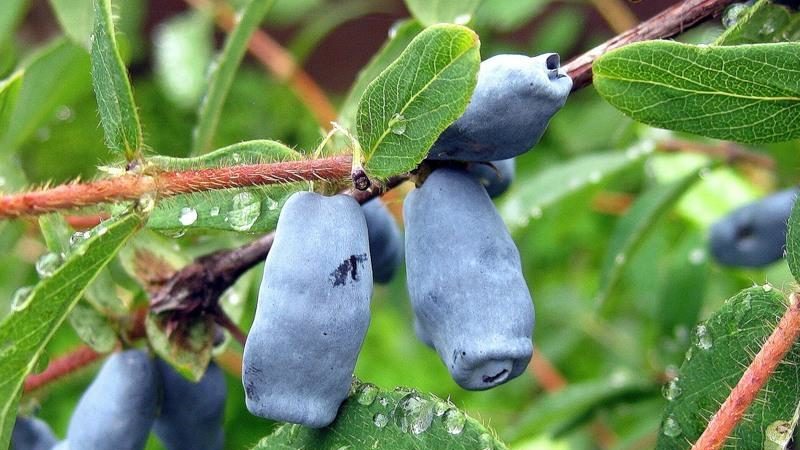
Is it possible to eat honeysuckle while losing weight?
Edible honeysuckle fruits are a dietary and healthy product. Even with obesity and endocrine disorders, it can be included in your diet.
Is it acceptable on a diet?
For a balanced diet, during therapeutic fasting, diets, vitamins and minerals are necessary for the body.
Honeysuckle with a high content of calcium, sodium, phosphorus, silicon supports the body and has a beneficial effect on all organs and systems:
- strengthens the immune system;
- provides muscle activity;
- cleanses the blood, reduces cholesterol and sugar levels;
- normalizes digestion;
- calms the nervous system;
- supports the functioning of the heart and vascular bed;
- reduces blood pressure (diuretic effect);
- stimulates “dormant” metabolism during exercise.
Read also:
Do berries make you fat?
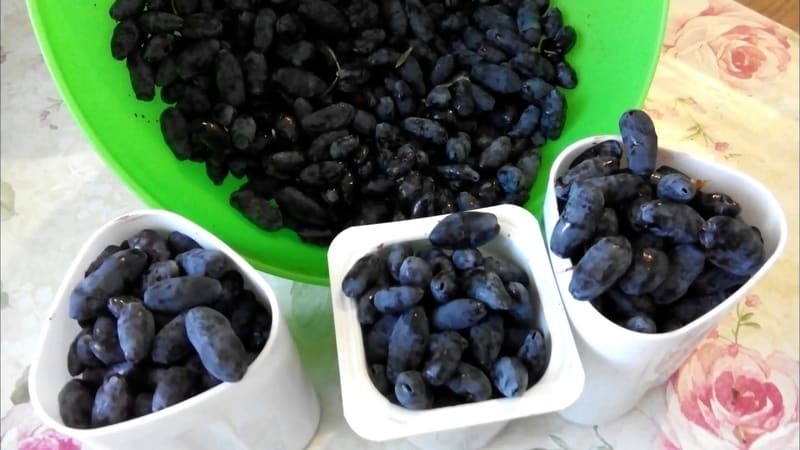
When adhering to a diet and healthy eating, several points should be taken into account:
- daily consumption rate - it will be calculated by any calorizer program, calorie calculator or food analyzer;
- product compatibility - BJU ratio;
- caution - follow medical contraindications.
This is interesting. Ancient Chinese manuscripts note honeysuckle as a medicinal and antidote plant. Antidotal berries relieved poisoning, dysentery, and edema. Doctors used the fruits as a diuretic and cleanser.
Whether frozen or fresh, the berries will not harm overweight people. But you can’t sprinkle them with sugar, powdered sugar, whipped cream, full-fat sour cream or creams.
How it is useful in the fight against excess weight
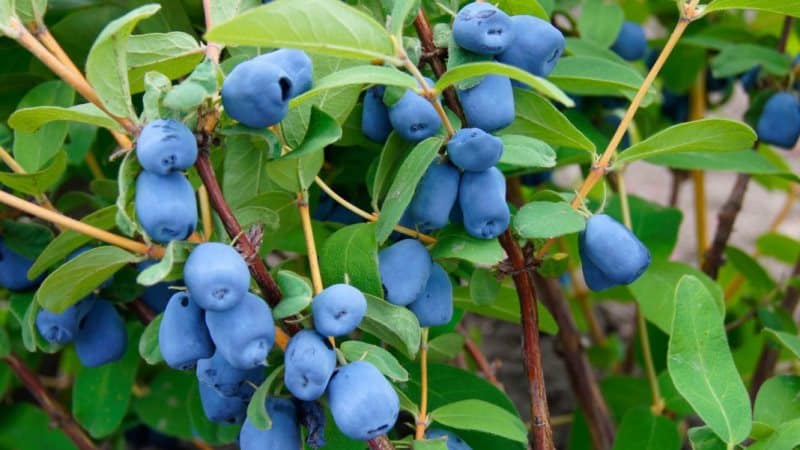
Edible honeysuckle fruits are low-calorie, they help burn fat and normalize metabolism.
Benefits of honeysuckle as a dietary berry:
- Organic acids provide conditions for normal digestion. In case of chronic fatigue and vitamin deficiency, they perform a protective function. For example, vitamin C, in addition to antibacterial and immunostimulating properties, improves blood supply to the epidermis. Thanks to ascorbic acid, facial skin, even with strict diets, has a healthy appearance, radiance and natural blush.
- Pectins – natural sorbents, collect toxins and waste from the intestinal walls, and remove heavy metal salts in a gentle manner. Stool and peristalsis of the entire intestinal tract are normalized.
- P-active substances-flavonoids (catechins, anthocyanins, rutin) normalize blood pressure. Prevents vascular diseases, hemorrhages in the heart and cerebral cortex. Actively resist ulcerative lesions in the intestines. These substances are also antioxidants with protective properties. Vitamin P is essential for maintaining good physical fitness and mental activity.
- B vitamins participate in the metabolism of amino acids. They resist pathologies of the nervous, vascular and digestive systems.
- Carotenoids – vitamins of youth, participate in the growth of new cells, in the production of protein, form cellular and subcellular membranes. A deficiency of vitamins A leads to wrinkles, dry hair and scalp (dandruff, psoriasis).
- Minerals support all organs and vital systems of the body. Iodine, for example, burns excess fat and activates mental activity.Iodine deficiency causes weight gain, hormonal imbalances in women (menstrual irregularities), decreased libido and sexual activity in men. Magnesium, phosphorus and sodium ensure a healthy nervous system and promote muscle activity. Together with B vitamins and potassium, they are directly involved in metabolism.
- Potassium and sodium support the vital activity of soft tissues - blood vessels, endocrine glands. Affects the contraction of skeletal muscles. Regulates salt, alkaline and acid metabolism, reduces swelling. Lack of sodium has a negative effect on the body (dehydration, fatigue, muscle weakness). During physical activity, a deficiency of potassium, sodium and magnesium affects a person’s condition - dizziness, shortness of breath, muscle cramps, and excessive sweating. And without phosphorus, muscles don’t work at all.
Actively engaging in fitness, therapeutic exercises, running, Pilates or yoga without a sufficient amount of microelements and vitamins in the body is problematic; the body will not withstand the stress.
Standards of use
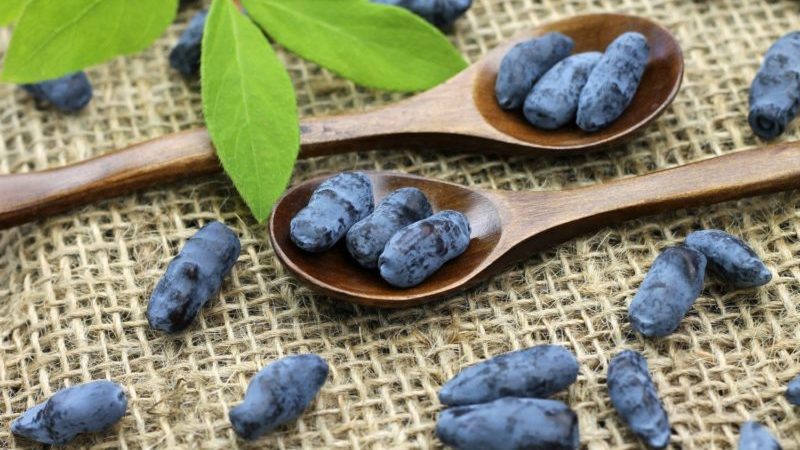
Nutritionists calculate the daily intake of berries according to the following scheme:
- collect anamnesis (age, concomitant pathologies, primary medical indicators);
- carry out an analysis of the nutritional value, chemical composition, and ratio of the product's BJU;
- calculate the ratio of daily needs for vitamins, sugars and minerals;
- Based on an individual calorie chart, the permissible daily dietary allowance is calculated.
Important. 1 g of protein contains 4-5 kcal, 1 g of carbohydrates contains 4 kcal, and 1 g of fat contains 9-10 kcal.
To correctly calculate the daily norm, the following units of measurement (average values) are used:
- 1 berry – 1.5-2 g;
- 1 tsp. – 5-7 g;
- 1 tbsp. l. – 18-25 g;
- 1 glass – 200-250 g.
How and with what to eat
It is advisable to consume fresh berries during the season. For the winter, the berries are frozen. When frozen, beneficial substances lose their properties slightly, by 2-4%.
During heat treatment, vitamins are lost by 30-40%. Fresh berries are used to make jam, compotes (unsweetened), jellies, purees, and jams.
Smoothies, cocktails, desserts with fresh berries based on low-fat yogurt, yogurt, kefir - an excellent dessert or breakfast.
Recipes with honeysuckle for weight loss
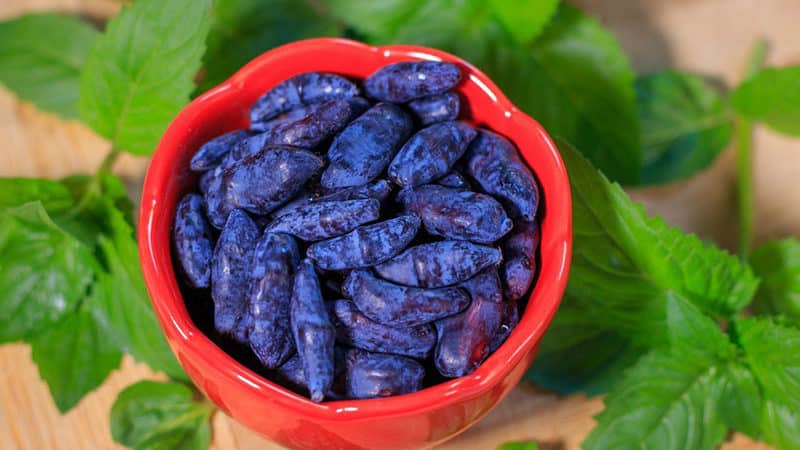
Herbalists and traditional healers use the bark, young branches and leaves to make tonic infusions for anemia, vitamin deficiency, and loss of strength.
Diuretic decoction
A diuretic decoction for fluid retention in the body, situational and chronic edema (junk food, protein metabolism disorder) is prepared simply:
- 1 tbsp. l. crushed dry bark, pour hot water, 250 ml;
- simmer over low heat or in the oven for 5 minutes;
- leave for 2 hours, strain;
- take 3 times a day before meals, 1-2 tbsp. l. within a month.
A healing, restorative drink that is useful during therapeutic fasting, dieting, and fasting days. Recipe:
- Pour 20 g of flowers or buds with 1 glass of boiling water;
- simmer over low heat for 2-3 minutes;
- leave for 1 hour, strain;
- drink 2 tbsp. l. 2-3 times a day before using food for 3-4 weeks.
When losing weight, it is important to diversify your diet. Sweet desserts with honeysuckle berries are healthy, nutritious and easy to prepare.
Berry mousse
Ingredients:
- 1 glass of honeysuckle berries (you can mix 50/50 with other berries);
- 3 egg whites;
- 0.5 tbsp. Sahara.
Preparation:
- Wash the berries, dry them, pour them into a container;
- add proteins and sugar;
- beat with a mixer or blender until thick, 5 minutes;
- Place in bowls or dessert glasses and garnish with mint leaves.
Low-calorie cottage cheese casserole
Compound:
- 300 g low-fat cottage cheese;
- 1 egg;
- 2-3 tbsp. l. Sahara;
- 3-4 tbsp. l. honeysuckle berries;
- 1 medium sized apple.
Step by step recipe:
- mix dried berries with egg, cottage cheese, sugar;
- blend the mixture in a blender;
- pour the mixture into a silicone mold;
- garnish with apple slices;
- bake in the microwave for 5 minutes.
Contraindications
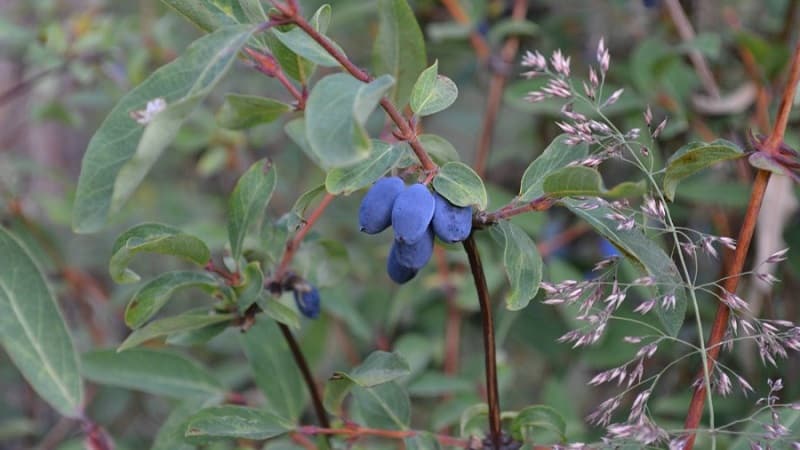
Edible honeysuckle berries have no direct contraindications.
Features of use:
- Children under 6 years of age are recommended to include in the diet in small portions - up to 50 g per day;
- Pregnant women are allowed a minimum daily intake of 2-3 tbsp. l. per day;
- when breastfeeding in the first month of a child’s life, it is not recommended to include fresh berries in the menu due to the baby’s increased sensitivity to allergens;
- Fresh berries can be introduced into the diet from 3-4 months after the child’s birth in minimal doses;
- in people suffering from food allergies, the coloring pigments of the fruit cause an allergic reaction (itching, hives, swelling of the face and hands);
- you should not overuse berries, the daily norm for an adult is 100-150 g (excess vitamin C disrupts the acid balance in the mouth and destroys tooth enamel);
- in case of chronic pathologies of the stomach (ulcers, gastritis), exacerbation is possible due to the acids contained in the fruit;
- for urolithiasis, kidney pathologies, gallstones, the dosage is limited; against the background of oversaturation and overeating, there is a load on the excretory system.
Read also:
Frost-resistant early ripening honeysuckle variety “Lakomka”
Conclusion
Varieties of edible honeysuckle can be selected for any location and climate zone. The plasticity, unique precocity and usefulness of the crop are appreciated by amateur gardeners, experts from agricultural holdings and horticultural companies.
In terms of chemical composition, the fruits are not inferior to garden crops - gooseberries, raspberries, strawberries. Berries are useful for vitamin deficiency, loss of strength, and increased physical activity. They tone blood vessels, normalize blood pressure, and cleanse the blood.
When losing weight, a complex of vitamins, minerals, pectins and flavonoids strengthens the immune system, keeps the body in good shape, removes toxins, salts, radionuclides and gently cleanses the intestines.